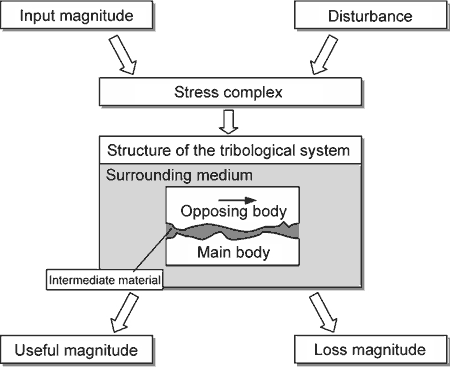5.7.1.2 Tribological
systems
Generally speaking, friction and wear are
thought of as reflecting the losses in tribological systems.
They depend not only on the properties of the individual materials,
but also on interactions that occur and on the magnitudes
of all the stresses operating in the system. Under some circumstances,
even small changes in the system can have significant effects
on the coefficient of friction and on the degree of wear.
Friction and wear are therefore
properties of a system, not simply characteristics of individual
materials!
A tribological system consists of these
four elements: the main body, the opposing body, the intermediate
material and the surrounding medium. These, together with
the total of all the stresses involved, which we may call
the stress system, determine the coefficient of friction,
the type of wear and the level of wear that occurs.

Figure 94: Representation of a tribological system
The stress system is composed of the technical
and physical parameters of the normal force, FN, the velocity,
v, the temperature, T, the duration of the stress ts, the
types of movement and the changes of these factors over time.
In practice, tribological systems are divided into
- closed tribological systems such as
bearings and seals, corresponding to Figure 94 and
- open tribological systems such as chutes,
channels and pipe systems. In these cases, the function
of the opposing body, which is not present, is performed
by the intermediate material.
Systematic analysis of a tribological reaction is treated
in DIN 50 320.
|
|

